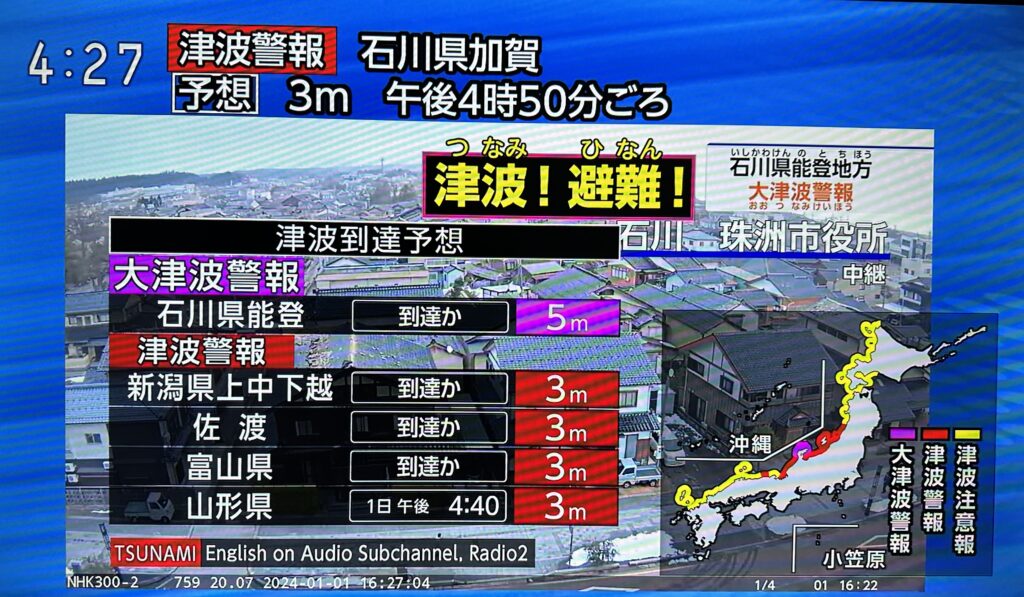
- ARAB NEWS
- 02 Jul 2025

TOKYO: After a 7.6-magnitude earthquake struck off the north coast of Japan at 4:10 p.m. on New Year’s Day, there were concerns for the many nuclear power plants in the area.
Cabinet Secretary HAYASHI Yoshimasa confirmed that a fire had broken out in a transformer at a nuclear power plant in Ishikawa Prefecture. Nuclear power companies in the region said there were no other immediate reports of abnormalities as emergency response teams checked radiation levels.
Hayashi said there were also reports of landslides, and some people had been trapped.
#BREAKING: #Japan Chief Cabinet Sec. Hayashi shares in a press conference that there have been 6 reported cases of people being stuck under the rubble as buildings collapse in #Ishikawa following the earthquake. No deaths were reported.https://t.co/Z9OjXEqIKM pic.twitter.com/vMFIg1RYKb
— Arab News Japan (@ArabNewsjp) January 1, 2024
A 5-meter tsunami warning is in effect for the Noto Peninsula in Ishikawa Prefecture, and residents have been told to evacuate to high ground immediately.
There were fears of a major nuclear disaster, as happened in Fukushima 13 years ago when the Daiichi Nuclear Plant was hit by a 15-meter tsunami. The current tsunami warnings are the first major tsunami warnings since 2011.
The predictions are for much lower waves, but tsunami alerts are not always accurate, and waves that reach land can be larger or smaller than predicted.
Fukui and Shimane nuclear plant officials reported no irregularities in the plants to the west of Ishikawa Prefecture.
Tokyo Electric Power Company (TEPCO), which also runs the wrecked Daiichi plant in Fukushima, inspected the impact of the quake and found no changes in the monitoring posts around the plants.
Other plants in the area include TEPCO’s Kashiwazaki-Kariwa Nuclear Power Plant (Niigata Prefecture), located on the Sea of Japan, Japan Atomic Power Company’s Tsuruga Nuclear Power Plant (Fukui Prefecture), Kansai Electric Power Company’s Mihama Nuclear Power Plant (FukuiPrefecture), Kansai Electric Power’s Oi Nuclear Power Plant (Fukui Prefecture) and Takahama Nuclear Power Plant (Fukui Prefecture). So far, no abnormalities have been discovered in these plants.
A number of buildings have been reported to be collapsing in the area, with some people trapped inside. According to the Ishikawa Prefectural Police Suzu Police Station, many people are believed to have sustained injuries.
Bullet trains have been stopped in the area, and transportation has been disrupted.
A major fire has been reported in the center of Wajima City, while in Toyama Prefecture, there are reports of power outages and cracked roads.
#WATCH: A fire broke in #Wajima, city along the coast of #Ishikawa, following the earthquake. https://t.co/Z9OjXEqIKM
— Arab News Japan (@ArabNewsjp) January 1, 2024
(🎥:@29912190) pic.twitter.com/gRPdLqHq1b
In Suzu City in Ishikawa Prefecture, the hospital was operating on emergency power after a power cut, while at a hospital in Wajima City, patients were being treated in the car park.
Strong aftershocks have been reported, including one measuring 6.2 on the Richter Scale and 10 of around 5 on the Richter Scale. The initial major quake registered a maximum of 7 on Japan’s seismic scale.
Initial waves of around 2 meters have been observed in Ishikawa Prefecture, but larger waves are expected to follow.
The force of the quake was felt over large areas of Japan, including Tokyo, where buildings shook and swayed. The seismic intensity in Tokyo was 4.
Prime Minister KISHIDA Fumio said in a press conference that his government is taking measures to deal with the quake’s aftermath and following up on the situation with the Disaster Response Task Force.
#BREAKING: #Japan's PM Kishida urges people to evacuate following a series of strong quakes in the Sea of #Japan.https://t.co/Z9OjXEqIKM pic.twitter.com/4CwUlWBlIU
— Arab News Japan (@ArabNewsjp) January 1, 2024
He said he would make sure the information released would be as quick and accurate as possible, quake damage would be evaluated quickly, and everything possible would be done to save lives.
Japan’s Self-Defense Forces dispatched aircraft over the disaster-stricken areas to assess the situation, the Ministry of Defense reported.